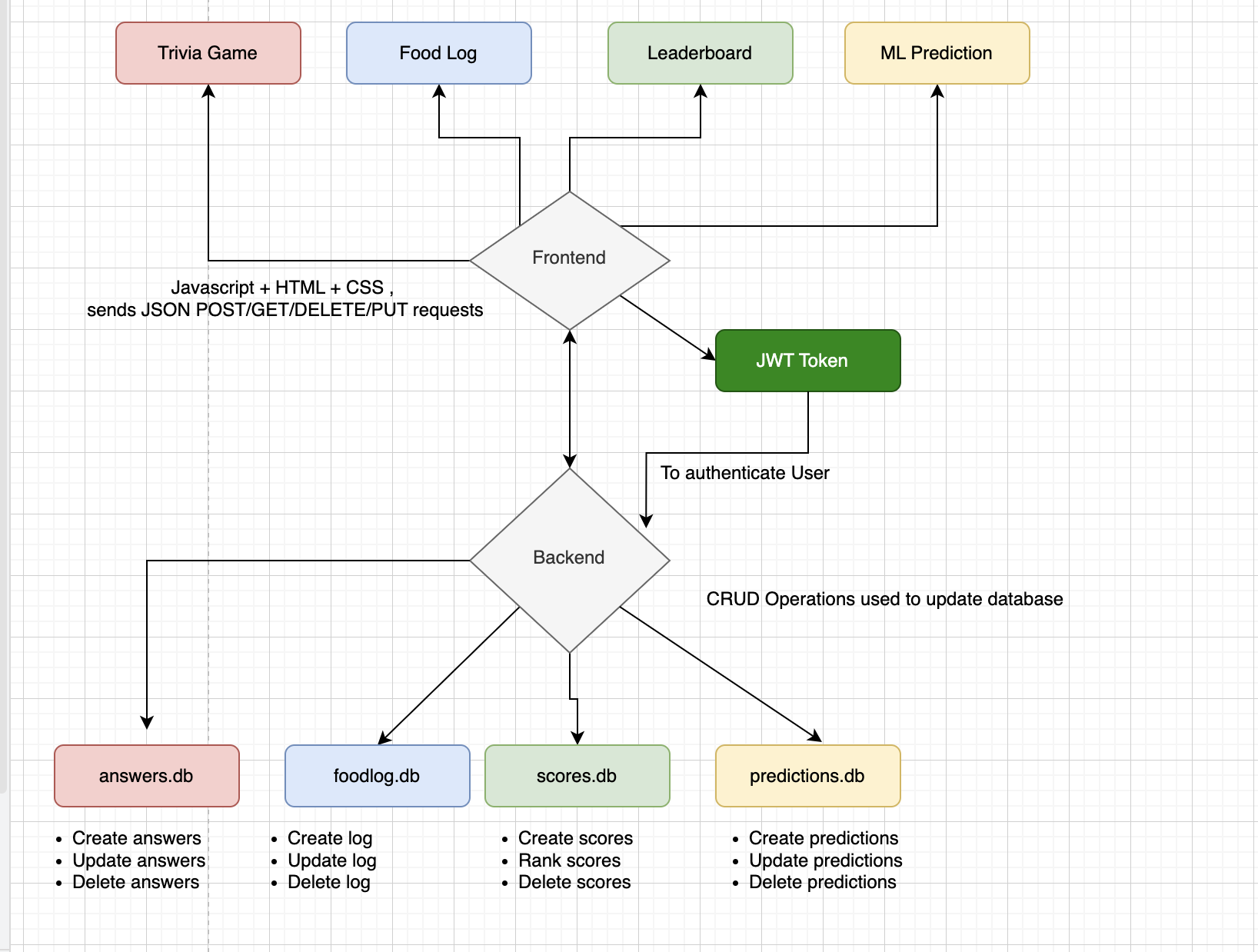AWS Deployment Blog
Project Structure

Backend
- Our backend is Flask-based, running on port 8520 for API requests.
- It processes event data, manages user profiles, and handles notifications.
- All API routes are managed in
main.py, with separate modules for each feature.
Frontend
- The frontend runs on port 4887, communicating with the backend via RESTful APIs.
- It fetches and updates data dynamically, enhancing user experience.
- The frontend sends API requests to the backend, which interacts with the database and returns data.
- The user interface updates accordingly based on API responses.
Features Working with Frontend to Backend
Racing Car Game with Leaderboard
- Backend: Manages game sessions, scores, and leaderboard data via
/api/scores. - Frontend: Runs the racing game, submits scores, and displays the top 10 players on the leaderboard.
- Database: Stores player profiles, game scores, and ranking info.
Perfect Plate Game with Leaderboard
- Backend: Handles game logic, user attempts, and leaderboard updates at
/api/scores. - Frontend: Lets users build their “perfect plate,” submits results, and shows the top 10 players.
- Database: Saves user game results and leaderboard standings.
Food Log with Glycemic Index Calculation
- Backend: Accepts food entries, calculates glycemic index impact at
/api/food_log. - Frontend: Allows users to log foods eaten, displays glycemic index info and daily summaries.
- Database: Stores user food logs, glycemic index values, and nutritional info.
Pin the Dexcom Game
- Backend: Tracks user placements of the Dexcom CGM and stores glucose data throughout the day at
/api/pin_dexcom. - Frontend: Provides an interactive “Pin the Dexcom” game for CGM placement practice and displays glucose trends over time.
- Database: Saves user pin attempts and glucose readings for progress tracking.
Deployment Process on AWS
Prerequisites
- Ensure the frontend and backend are properly connected and tested locally.
- Prepare the necessary configuration files, including
Dockerfile,docker-compose.yml, andnginxsettings. - Set up a DNS subdomain using AWS Route 53.
Initial Deployment Steps
- Clone the repository:
git clone <repo-url> cd <project-directory> -
Create a
.envfile inside the backend project folder and add necessary environment variables (such as passwords). - Initialize the database:
./scripts/db_init.py - Build and deploy using Docker:
docker-compose build docker-compose up -d - Verify the running container:
docker ps - Test the server:
curl localhost:8206 # Ensure the port matches your updated backend port
Port Selection & Docker Setup
- Choose a backend port (
8520) and ensure consistency across all configuration files. - Update
main.py,Dockerfile, anddocker-compose.ymlto use the correct port. - Test the Docker container locally using
docker-compose up.
AWS EC2 Access & Deployment
- Log in to AWS EC2 and clone the backend repository.
- Build and deploy the backend using:
docker-compose up -d --build
DNS & Nginx Setup
- Configure a subdomain via AWS Route 53.
- Set up an Nginx reverse proxy to route requests to the backend.
- Activate and validate the Nginx configuration.
SSL & HTTPS Configuration
- Use Certbot to obtain an SSL certificate for HTTPS.
- Redirect all HTTP traffic to HTTPS for secure access.
Maintaining Deployment
- Before making changes, pull the latest code from GitHub.
- Test changes locally before pushing updates.
- Restart the deployment on AWS by pulling changes and rebuilding the container.
Scalability, Security, and Reliability
Scalability: Handling Multiple Users Efficiently
- Gunicorn with Multiple Workers: Ensures efficient request handling.
- Dockerized Deployment: Allows easy scaling by running multiple containers.
- AWS Load Balancer (Future Consideration): Can distribute traffic if scaling beyond one instance.
Security: Protecting Data and Access
- Firewall & Security Groups: Restrict unauthorized access to the backend.
- JWT Authentication: Ensures secure API access.
- Nginx as Reverse Proxy: Adds an extra security layer by handling incoming requests.
- SSL/TLS Encryption (Certbot): Enables HTTPS for secure data transmission.
- Docker Isolation: Runs services in containers to minimize security risks.
Reliability: Keeping the App Running Smoothly
- AWS CloudWatch Logs (Future Consideration): Can be used for monitoring errors.
- Nginx Error Handling: Manages failures with proper routing.
- Automatic Container Restarts: Ensures uptime if a service crashes.
- Daily Backups (To Be Implemented): Helps prevent data loss.